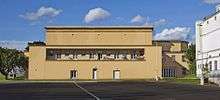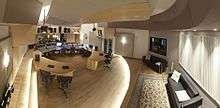Synchron Stage Vienna
Synchron Stage Vienna is a recording facility specializing in recording large orchestras and film music.[1] The landmark protected building, formerly "Synchronhalle" ("Hall 6") of the historic film lot "Film City Vienna" in the Austrian capital's 23rd district is operated by Vienna Symphonic Library.[2]
History

From its construction in the early 1940s until the 1950s, the facility shared its history with the Rosenhuegel-Filmstudios. At that time the "Synchronhalle" hosted as many as ten large orchestra film score projects per year. A remnant of the building's designated use is the preserved "Lenkwil" cinema organ with three manuals that features not only various instrumental timbres but also sound effects such as rolling thunder, car horns, clopping horses, twittering birds and ocean waves. It is the only cinema organ in the world that is still housed in its original scoring stage.[3] Because of this combination the Federal Monuments Office classified this building as a historical monument. In the mid 1960s, the complex was acquired by the Austrian Broadcasting Corporation (ORF), initializing an era of revival. Eminent classical artists such as Karl Böhm, Herbert von Karajan, Yehudi Menuhin, Sviatoslav Richter and Mstislav Rostropovich discovered the exceptional acoustic properties and used the "Synchronhalle" for many legendary recordings.[4] By the beginning of the 21st century, the hall had fallen into a state of disrepair but was still used as a rehearsal stage.[5] In summer 2013, the Viennese sample library and music software developer Vienna Symphonic Library acquired and began refurbishing the facility.[6] Synchron Stage Vienna with its acoustic design was nominated[7] for 32nd TEC Award at NAMM Show in Anaheim.[8]
The first project was recorded in October 2015 with Grammy Award winning recording and mixing engineer Dennis Sands and composer/orchestrator/conductor, Conrad Pope.[9] Shortly after the official opening, Hans Zimmer's Remote Control Productions chose Synchron Stage Vienna to record a whole slate of productions, including music for Inferno, starring Tom Hanks (directed by Ron Howard, music by Hans Zimmer), and the Netflix series The Crown by Peter Morgan (music by Hans Zimmer and Rupert Gregson-Williams).[10]
In March 2016, the Vienna Symphonic Library business offices moved into the new facility.[11]
Recording facilities


Synchron Stage Vienna is a recording facility that merges traditional and novel recording technologies and workflows with Vienna Symphonic Library's software innovations.[12] It combines a scoring stage with several studios, isolation booths and office space used by clients and Vienna Symphonic Library's software and sample development business. Stage A, the large main hall, accommodates orchestras of up to 130 musicians and is built as a room-in-room construction, with an up to 10-foot gap between walls, ensuring entire sonic isolation from outside noise.[10] Additional studios and offices surround the central stage, including Stage B, another recording room, Control Rooms A and B, several lounges, isolation booths, instrument storage rooms and a score archive.[11] The facility offers the ability to route any signal source to any room of the building, including offices, without any latency or loss of audio quality.[13] The stages and control rooms can be configured modularly depending on the recording requirements. Film composers can record their scores or augment their virtual symphonic cues with a real orchestra.
The basement comprises storage rooms for pianos and 300 percussion instruments. All rooms are connected to the same ventilation system used by the recording stages, so the stored instruments are always pre-acclimated for recording.[14] An elevator connects the storage rooms directly with Stage A.[15]
Synchron Stage Vienna currently offers three concert grand pianos, a Steinway D-274 and two remotely accessible pianos, a Bösendorfer 290 Imperial with CEUS performance reproducing system and a Yamaha Disklavier CFX EN PRO.[16] The Bösendorfer CEUS technology[17] and the Yamaha Disklavier reproducing system incorporate computer controlled mechanisms to record performances and accurately play them back on the acoustic instrument. With the CEUS system, solenoids activate each key and pedal to mirror the original, recorded performance. The ability to accurately capture a performance in terms of timing and loudness is an important step in retaining the player's unique expression.[18] The performance reproducing pianos have several applications, e.g., a recorded piano performance can be edited in order to correct notes or to adjust dynamics and timing. Furthermore, a single pianist has the opportunity to perform a piece for four hands, accompanying an initial performance with a second take. A piano performance, played anywhere in the world, can be reproduced and recorded in one of Synchron Stage's rooms.[15]
References
- Burger, Susanna. "Library Of Sound" (PDF). Vienna Journal. 2016: 6. Retrieved 20 April 2017.
- Hartlauer, Helena. "City of film music". Vienna Tourist Board. Retrieved 20 April 2017.
- Marz-Wagner, Sylvia. "Synchron Stage Vienna opening". OTS – Official Austrian press information (Press release). Austrian Press Agency. Retrieved 30 Nov 2016.
- Schloegl, Stefan (26 September 2016). "Sounds like Rosenhuegel". Zeit Online. 40/2016: 1–2. Retrieved 19 April 2017.
- Maebe, Wes (2 May 2016). "On The Cover: Synchron Stage Vienna". Mix. 40 (5): 12–15. Retrieved 26 September 2016.
- Minnameier, Christoph. "Synchron Stage Vienna". Prof. Dr. Minnameier. Retrieved 23 September 2016.
- Ebbinghaus, Peter. "Synchron Stage Vienna Nominated for NAMM TEC Award for Outstanding Creative Achievement". Soundtracks And Trailer Music. Retrieved 20 April 2017.
- "32nd TecAwards Nominee: Studio Design Project". tecawards.org. Retrieved 20 April 2017.
- Mikusz, Thomas. "Grand Opening Of Europe's New Scoring Stage: Synchron Stage Vienna" (Press release). White Bear PR. Retrieved 18 July 2016.
- Burlingame, Jon (2 May 2016). "Synchron Stage Vienna Offers Film Composers an Austrian Alternative". Variety. 2016 (5).
- "Synchron Stage Vienna". Vienna Symphonic Library. Retrieved 16 April 2017.
- McCue, Michelle. "Composers Hans Zimmer, Rupert Gregson- Williams Head To SynchronStage Vienna To Record Scores". IMDb. Retrieved 20 April 2017.
- "SSL Case Study: Synchron Stage Vienna" (PDF). Solid State Logic. Retrieved 23 November 2016.
- "VSL Launches Synchron Stage Vienna". Pro Sound News. Retrieved 20 April 2017.
- "Synchron Stage Vienna". Synchron Stage Vienna. Retrieved 10 April 2016.
- "Synchron Stage Vienna looks to the future with Yamaha CFX Disklavier". Yamaha Music Europe GmbH. Retrieved 20 April 2017.
- Cohen, Martin. "CEUS Reproducing System Of My Bösendorfer Imperial 290 Piano". www.company7.com. company7. Retrieved 22 April 2017.
- Bernays, Michael (4 March 2014). "Investigating pianists' individuality in the performance of five timbral nuances through patterns of articulation, touch, dynamics, and pedaling". Frontiers in Psychology. 5: 157. doi:10.3389/fpsyg.2014.00157. PMC 3941302. PMID 24624099.